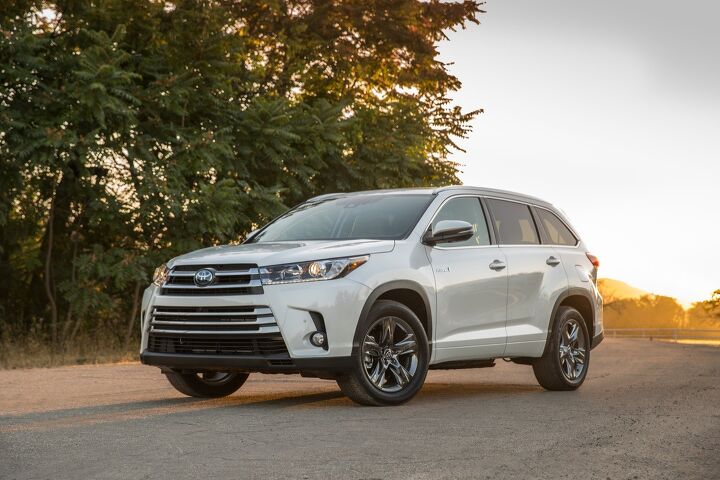Finally, The Toyota Highlander Hybrid Is Affordable And Actually Starts To Make Sense
For far too long, the Toyota Highlander Hybrid has been an especially costly version of Toyota’s popular three-row crossover.
Fortunately, the Toyota Highlander Hybrid’s base price drops by $11,600 in 2017 as Toyota introduces two additional lower trim levels, which have eased the cost burden of upgrading to the hybrid.
Launched in 2006, the first Toyota Highlander Hybrid was 35 percent more costly than the basic Toyota Highlander of the same era. More recently, in the 2016 model year, the Toyota Highlander Hybrid AWD was 43 percent more expensive than the least costly V6 AWD Highlander; $17,380 more than the entry-level, front-wheel-drive, four-cylinder Highlander.
The gap wasn’t so vast in apples-to-apples comparisons. Toyota traditionally limited the Highlander’s hybrid powertrain to buyers who wanted particularly well-equipped Highlanders. In 2016, for instance, the only Highlander Hybrids were Limiteds and Platinums with all-wheel drive. Compared with a non-hybrid Limited, the Highlander Hybrid Limited still represented a premium option: $5,495, or a 13-percent hike. But that hike wasn’t entirely out of sync with what we’ve become accustomed to in the gas versus gas/electric world.
Having now learned with the RAV4 just how successful a hybrid SUV can be, Toyota is employing a similar strategy with the larger Highlander.
In 2016, having introduced lower trim levels and improved availability, Toyota reported 45,097 RAV4 Hybrid sales. That’s better than one-in-ten RAV4 sales; more RAV4 Hybrid sales than some 50 SUVs/crossovers managed in 2016.
The strategy for the Highlander Hybrid can’t be the same now as it was a decade ago. “When gas was $4, the market would accept a certain premium for hybrids. Today at $2.50, it’s a much smaller premium that’s acceptable,” Toyota’s North American CEO Jim Lentz told Wards Auto.
Understanding this, added to the Highlander Hybrid Limited and Platinum trims are new LE and XLE trims. At $37,265 including fees, the 2017 Highlander Hybrid LE AWD now costs $2,130 more than the Highlander LE V6 AWD. The Highlander Hybrid XLE AWD is only $1,745 more than the non-hybrid XLE AWD. The Highlander Hybrid Limited AWD and Hybrid Platinum AWD demand only a $1,620 premium compared with their equivalent non-hybrid AWD siblings.
Combined fuel economy for the regular Highlander V6 AWD tops out at 23 miles per gallon. Highlander Hybrid combined fuel economy rises as high as 29 mpg, saving the Highlander Hybrid driver roughly $300 in fuel costs per year.
In 2016, only 3 percent of the Highlanders sold were hybrid-powered. It’s unlikely the hybridized Highlander will form as significant a portion of overall Highlander sales as the hybrid power does for the RAV4. But in concert with improvements across the Highlander range for 2017, improved hybrid pricing should aid the Highlander in repeating 2016’s performance as the best-ever year for Highlander sales in America.
Timothy Cain is the founder of GoodCarBadCar.net, which obsesses over the free and frequent publication of U.S. and Canadian auto sales figures. Follow on Twitter @goodcarbadcar and on Facebook.
More by Timothy Cain
Latest Car Reviews
Read moreLatest Product Reviews
Read moreRecent Comments
- Kwik_Shift_Pro4X At the taxpayers expense, as usual.
- Danddd Or just get a CX5 or 50 instead.
- Groza George My next car will be a PHEV truck if I can find one I like. I travel a lot for work and the only way I would get a full EV is if hotels and corporate housing all have charging stations.I would really like a Toyota Tacoma or Nissan Frontier PHEV
- Slavuta Motor Trend"Although the interior appears more upscale, sit in it a while and you notice the grainy plastics and conventional design. The doors sound tinny, the small strip of buttons in the center stack flexes, and the rear seats are on the firm side (but we dig the ability to recline). Most frustrating were the repeated Apple CarPlay glitches that seemed to slow down the apps running through it."
- Brandon I would vote for my 23 Escape ST-Line with the 2.0L turbo and a normal 8 speed transmission instead of CVT. 250 HP, I average 28 MPG and get much higher on trips and get a nice 13" sync4 touchscreen. It leaves these 2 in my dust literally



































Comments
Join the conversation
So what does this do to depreciation for 2016 and older owners? I'm guessing it isn't pretty...
Toyota needs to pair this with a 4 cylinder to get a more serious mpg improvement. Make it cheaper than the Pacifica hybrid and the most fuel efficient 3 row vehicle aside from that.